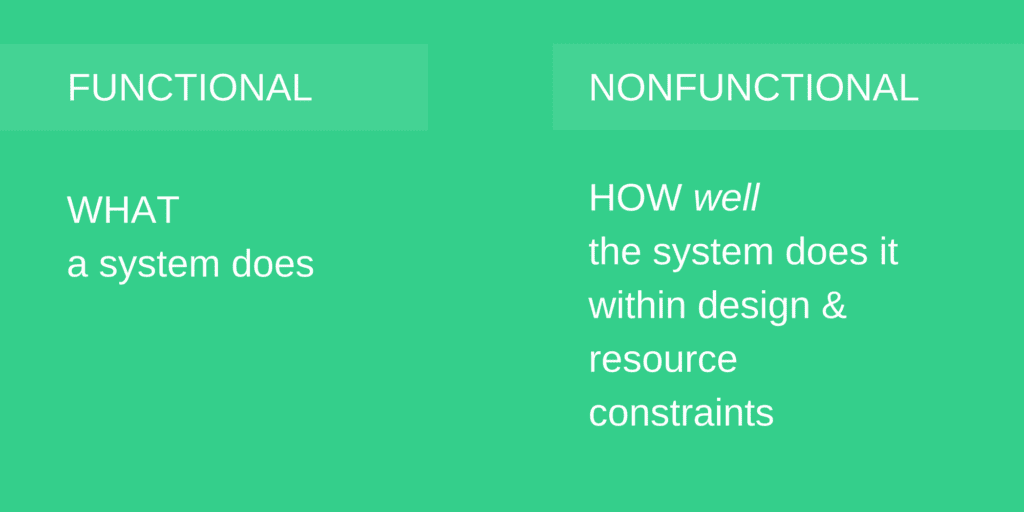What’s the Difference Between Functional and Nonfunctional Testing?

Well-designed quality assurance strategies and plans generally include functional testing and non-functional testing. Therefore, understanding the difference between functional and nonfunctional testing is crucial for testing and QA teams. While both constitute an important part of the application evaluation process, they serve very distinct purposes.
Let’s start by asking what functional testing is. Functional testing verifies product features work according to requirements, identifying all areas where performance doesn’t meet expected results.
On the other hand, non-functional testing performs checks on wider quality concerns, verifying all non-functional aspects of the software application (such as usability, performance, compliance, etc.).
Functional vs. Non-Functional Testing Requirements
Before we can understand the difference between functional and non-functional testing, we need to know the difference between functional and non-functional requirements:
- Functional Requirements describe the behavior/execution of the software system.
- Non-Functional Requirements describe the performance or usability of the software system.
While a functional requirement will specify that a feature must execute some action, a non-functional requirement might specify the speed with which the feature performs that action. Functional requirements are the WHAT; nonfunctional requirements are the HOW.
The Difference Between Functional and Non-Functional Testing
The testing of functional requirements verifies that the software is executing actions as it should, while non-functional testing helps verify that customer expectations are being met.

Functional Testing Versus Non-Functional Testing Table
To help make the difference even more clear, here are side-by-side examples:
| Functional Testing | Non-Functional Testing |
| When inputs are valid, the app login functions | After login, the dashboard loads within 3 seconds |
| When email notifications are on and the user receives a new message, an email notification is sent | The email notification is sent within 5 minutes |
| When a JPG file under 1MB is uploaded, the uploader accepts the file | When eight files or less (each under 1MB) are uploaded at the same time, the queues all |
| When the settings menu item is clicked, the settings page loads | The settings page has a matching appearance to the rest of the GUI |
Functional Testing Strategies
Functional testing covers a wide range of strategies for validating that software behaves as expected. To achieve thorough test coverage, it’s best to combine manual and automated approaches.
Most functional testing strategies are rooted in black-box testing methods, where the internal code structure is not examined. Instead, the focus is on validating the software’s functionality by inputting various data combinations and observing the outcomes.
Below are some of the key functional testing techniques:
1. Installation Testing
Installation testing verifies that the software can be installed and uninstalled in its intended environments. It ensures that the installation process is smooth and error-free and the software is compatible with different operating systems (OS) and platforms.
For example, when testing a new desktop application, installation testing would verify that the application installs without issues. It also verifies that the required files are placed in the correct directories and that the software launches correctly after installation.
2. API Testing
API testing verifies the functionality, reliability, performance, and security of application programming interfaces (APIs). It ensures that APIs return the correct responses for various requests, handle errors, and maintain data integrity.
For instance, in a weather application, API testing would send requests for weather data to the API and validate that the responses are accurate, timely, and formatted as expected.
3. Regression Testing
Regression testing ensures that recent changes or additions to the code have not adversely affected existing functionalities. It involves re-running previous tests and validating that everything still works as expected.
For example, after adding a new feature to an e-commerce website, regression testing would check that the new feature works correctly. It would also verify that previously functioning features, like the checkout process, remain intact.
4. Unit Testing
Unit testing involves testing individual components or units of a software application in isolation. It aims to validate that each unit functions as intended, typically at the code level.
Unit testing is a white-box technique that ensures each component operates correctly before it is integrated and tested as part of the overall system.
For example, in a calculator application, unit testing would test individual functions like addition, subtraction, multiplication, and division separately to ensure they produce the correct results.
5. Smoke Testing
Smoke testing is a preliminary test to check the essential functionality of the software. It ensures that the most critical functions work and that the software is stable enough for more rigorous testing.
Suppose you’re smoke testing a new web application for user authentication. You’d check if users can register and log in with valid credentials and ensure the login process follows the correct steps.
You may also need to verify that error messages appear for incorrect credentials. Passing these checks confirms the application’s core functionalities are stable enough for further testing.
6. Equivalence Partitioning
Equivalence partitioning is a technique used to reduce the number of test cases by dividing input data into equivalent partitions. Each partition represents a group of inputs expected to produce the same result, so only one test case per partition is needed.
For a login form that requires a password of 8-12 characters, equivalence partitioning would test with passwords of 7, 8, 12, and 13 characters. This is to validate the form’s behavior for different input ranges.
7. Boundary Value Analysis
Boundary value analysis is a technique where test cases are created to include values at the boundaries of input ranges. Since errors often occur at the boundaries, this method is effective in identifying edge cases.
For a form field that accepts ages between 18 and 65, boundary value analysis would test with ages 17, 18, 65, and 66. This is to ensure the field correctly handles values at and around the boundaries.
8. Error Guessing
Error guessing is a testing technique in which the tester uses their experience and intuition to anticipate potential errors or problem areas in the software.
They create functional test cases based on common errors, past defects, or areas known to be error-prone without following a systematic approach like in other testing methods.
A tester might use error guessing to test a login form by inputting incorrect credentials, leaving fields empty, or entering special characters. These inputs are expected to cause the application to fail.
Non-Functional Testing Strategies
Non-functional testing can sometimes require more creativity and technical expertise because you are testing what the customer expects for an overall quality experience—not X input leads to Y output.
Non-functional testing techniques are used to evaluate the performance, usability, reliability, and security of the system to ensure it meets the desired standards.
Here are some main non-functional testing techniques:
1. Load Testing
Load testing evaluates the system’s performance under expected or normal load conditions. It measures how the system handles a specific number of concurrent users or transactions and ensures that it performs within acceptable limits.
For a new e-commerce website, the tester would simulate 1,000 concurrent users browsing products. They might complete purchases to verify that the site remains responsive and performs well under this load.
2. Stress Testing
Stress testing determines how the system behaves under extreme conditions or beyond its maximum capacity. The goal is to identify breaking points, resource limitations, and how the system recovers from failure.
For a video streaming platform, the tester simulates ten times the usual number of users streaming videos simultaneously. This is to see if the system crashes, slows down, or shows errors under excessive load.
3. Scalability Testing
Scalability testing assesses the system’s ability to scale up or down in response to load or data volume changes. It ensures that the system can handle increased demands without performance degradation.
For a cloud-based application, a tester may add servers or resources to the system and verify that the application can handle the increased user load and maintain performance.
4. Volume Testing
Volume testing examines how the system handles large volumes of data. It assesses whether the system can process, store, and manage large amounts of data efficiently without impacting performance.
For a database management system, the tester would insert millions of records into the database to check if query performance remains acceptable and if the database handles the data without issues.
5. Security Testing
Security testing identifies software vulnerabilities, threats, and risks to protect data and resources from unauthorized access, breaches, and attacks.
For an online banking application, the tester would perform penetration tests to identify vulnerabilities. These tests include SQL injection, cross-site scripting (XSS), or insecure authentication mechanisms.
6. Disaster Recovery Testing
Disaster recovery testing ensures the system can recover and continue functioning after a catastrophic event, such as a hardware failure, data corruption, or a natural disaster. It verifies that backup and recovery processes are effective.
For a financial services application, the tester would simulate a data center failure and verify that the system can recover from backups.
They would also verify if the system can restore data and resume normal operations within the defined recovery time objectives (RTO).
7. Compliance Testing
Compliance testing verifies that the software complies with regulatory requirements, industry standards, and legal guidelines. It ensures that the system meets the necessary compliance criteria.
For a healthcare application, the tester may check that the software complies with regulations such as HIPAA (Health Insurance Portability and Accountability Act).
This is to ensure that patient data is handled securely and privacy is maintained.
8. Usability Testing
Usability testing evaluates software’s user interface (UI) and user experience (UX) by testing it with real users. The goal is to ensure that the software is intuitive, easy to use, and meets user expectations.
For a mobile banking app, usability testing would observe users perform tasks like transferring funds or checking their balance to identify any areas of confusion or frustration.
Optimize Your Testing Strategy With Teslio’s Functional Testing
Understanding the differences between functional and non-functional testing is essential for any testing strategy. While functional testing ensures your application behaves as expected, non-functional testing focuses on how the application performs under various conditions.
Listening to customer feedback plays a vital role. It can identify additional areas for improvement, such as app recovery after crashes or performance under constrained conditions.
This feedback helps refine the testing process, ensuring the functional and non-functional aspects meet user expectations and business requirements.
Need help with your functional testing?
Testlio offers a comprehensive range of functional testing services customized to your specific needs.
- Flexible staffing options: Access fully or co-managed services, with the flexibility to scale using on-demand, part-time, or full-time QA and QE professionals.
- Comprehensive testing services: Engage in thorough functional QA testing, including smoke testing, scripted and exploratory testing, and test automation management.
- Integrated testing platform: Leverage a versatile platform that supports all your testing needs.
- Smooth integrations: Use Testlio API and ready-to-use integrations for test management, CI/CD, automation, issue tracking, etc.

Ready to enhance your testing strategy? Partner with Testlio to ensure your application’s functionality is reliable! Contact us today to discover how Testlio can help you meet your functional testing goals.
